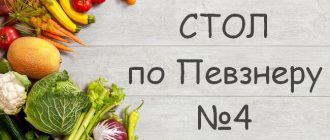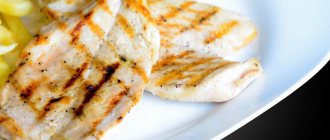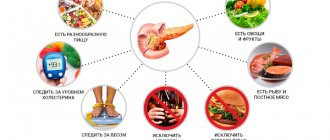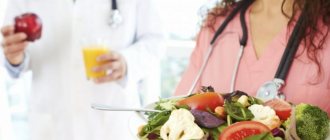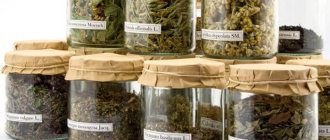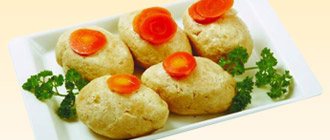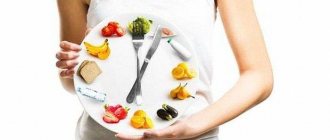11/24/2019 Article
- Purpose and general characteristics
- Table "Do's and Don'ts"
- Menu for the week
The “5 table” diet is a special therapeutic diet developed by the Soviet nutritionist M.I. Pevzner. It is considered one of the best diets for people suffering from diseases of the liver, biliary tract and gall bladder.
Indications for use:
- acute hepatitis and cholecystitis in the recovery stage,
- chronic hepatitis without exacerbation,
- cirrhosis of the liver without liver failure,
- chronic cholecystitis and cholelithiasis without exacerbation.
In all cases - without significant diseases of the stomach and intestines.
Find a trusted dietitian in your city and make an appointment online
Consultation with a nutritionist
What is possible with diet table No. 5
All dishes with this diet are steamed, boiled, stewed and served only warm. Sometimes it is allowed to bake a dish, but without a greasy crust. Be sure to drink a lot and eat in small portions: small portions 5 – 6 times a day.
- For the first course, pureed vegetable, dairy and cereal soups without meat are allowed. As a main dish, various lean meats and fish, chopped into small pieces, minced meat, soufflé, which are steamed or boiled. Oils are used only as dressings for dishes.
- You can eat low-fat dairy and fermented milk products. Casseroles are made from cottage cheese. Eggs are limited, cooked soft-boiled or included in omelets; you can eat no more than one yolk per day.
- It is imperative to use yesterday’s bread, not fresh; you can bake bread without oil and fat no more than twice a week. Crackers, biscuits, and dry biscuits are allowed. Recommended cereals: buckwheat, oats, semolina, rice. Pasta made from durum wheat can be used as complex carbohydrates.
- Vegetables are also boiled and baked, and eaten fresh. Particularly noteworthy are peas, carrots, beets, pumpkin, zucchini, tomatoes, potatoes and cauliflower, and cucumbers. You can eat non-acidic fruits: apples, bananas, pears. Herbs and spices are limited.
- For dessert, jellies, casseroles, puddings, dried fruits, and honey are allowed. Limited allowed: marshmallows, jam, marmalade. Suitable drinks include herbal teas, weak coffee with milk, weak tea, juices, jelly and compotes.
General provisions
Indications
Chronic hepatitis with signs of mild functional liver failure, chronic cholecystitis, cholelithiasis, acute hepatitis during the recovery period, chronic colitis with a tendency to constipation, chronic gastritis without severe disorders, chronic pancreatitis in remission.
Purpose
Meeting the body's need for nutrients and energy, restoring impaired liver and bile duct functions, mechanical and chemical sparing of the stomach and intestines, unloading fat and cholesterol metabolism, stimulating normal intestinal activity.
Characteristic
Normal content of proteins and carbohydrates while limiting refractory fats, nitrogenous extractives and cholesterol. Dishes are boiled or steamed, and also baked in the oven. Puree stringy meats and fiber-rich vegetables. The temperature of the prepared dishes is 20-52⁰С.
The basic principle
Frequent and small meals. Recommended every 3-4 hours in small portions.
Composition and energy value
- — Proteins – 100g,
- — fats 90g (of which 1/3 are vegetable),
- - carbohydrates 300-350 (of which simple (sugar) - 50-60g),
- — calorie content 2600-3000 kcal,
- — retinol 0.5 mg,
- — carotene 10.5 mg,
- - thiamine 2 mg,
- - riboflavin 4 mg,
- — nicotinic acid 20 mg,
- — ascorbic acid 200 mg,
- - sodium 4 g,
- - potassium 4.5 g,
- — calcium 1.2 g,
- — phosphorus 1.6 g,
- - magnesium 0.5 g,
- - iron 0.015 g.
- — Daily consumption of table salt – 6-10 g,
- - free liquid - up to 2 liters.
What not to do when dieting table number 5
- In dietary nutrition, spicy, fried, smoked foods are completely excluded, sour foods and salt are limited. You should not eat all sauces: ketchup, mayonnaise, hot seasonings.
- Soda, alcohol, cocoa and black coffee are prohibited. Dishes should not be too hot or cold.
- You cannot cook soups with meat, fish and mushroom broths. Fatty meat and fish, offal, canned food, and lard are prohibited.
- All fatty dairy products are excluded. Corn, pearl barley and wheat porridges are not recommended. Fresh bread and pancakes, pancakes, and products with cream are not allowed.
- Chocolate and ice cream will have to be avoided, as well as sour fruits such as cranberries or citrus fruits.
- Mushrooms, garlic, radishes, green onions are excluded, greens are limited.
This is interesting
Maggi, Mono, Japanese, Mediterranean: what types of diets are there [KP review]
Features of diet No. 5
In the acute stage of gastritis, the patient is prescribed diet No. 1 if the acidity is increased. This diet reduces the secretion of hydrochloric acid, but diet No. 2, on the contrary, increases it. Diet No. 5 is intended for gastritis with a parallel course of liver diseases. It improves fat metabolism and the functioning of the bile ducts.
Diet No. 5 can be prescribed in the presence of reflux (bile reflux), pancreatitis and other diseases of the liver and pancreas . Treatment Table #5 is a long-term nutrition plan designed for long-term recovery. In the first 5 days after the onset of the attack, the diet is not prescribed, but the patient is switched to it as soon as the symptoms begin to subside.
Compliance with therapeutic nutrition is the only way to sustainable remission. No medicine can protect the human body like this. Moreover, a balanced diet helps you lose weight and get rid of harmful substances accumulated in the body.
Menu for the week for diet table No. 5
Day 1
Breakfast : steamed omelet with hard cheese, coffee with milk Second breakfast: baked apple, you can add a little honey Lunch: vegetable soup, low-fat meatloaf, fruit compote Afternoon snack: crackers (without fillers), rosehip drink Dinner: buckwheat porridge, steamed cutlets turkey, tea Before bed: kefir
Day 2
Breakfast : low-fat cottage cheese with sour cream, oatmeal with milk and water, tea Second breakfast: handful of dried fruits, apple Lunch : beetroot, boiled chicken with white sauce, boiled rice, dried fruit compote Afternoon : apple jelly Dinner : buckwheat groats, berry compote Before bed : kefir
Krupenik recipe
- Boil 200 g of buckwheat in a large amount of water.
- Grate 200 g of cottage cheese, add a tablespoon of sugar, 100 ml of milk and one egg.
- Combine porridge and curd mass.
- Bake under foil until done.
Day 3
Breakfast : steamed carrot pancakes, coffee with milk Second breakfast: dry biscuits, dried fruit compote Lunch : pearl barley soup, baked vegetables, fish balls, compote Afternoon snack : fruit jelly Dinner : steamed chicken quenelles, boiled cauliflower, herbal tea Before bed : low-fat yogurt
Day 4
Breakfast : milk rice porridge, tea Second breakfast : dry biscuit, fruit compote Lunch: noodle soup, boiled chicken, vegetable puree, tea Afternoon snack : tea with biscuits Dinner : steamed cabbage rolls, herbal tea Before bed : banana
Day 5
Diet.
Photo: Pixabay Breakfast: oatmeal with milk, tea Second breakfast: wheat toast with mashed cottage cheese Lunch : pureed vegetable soup, beef stew, tea Afternoon snack: lazy dumplings, compote Dinner: milk noodle soup, biscuit, tea Before bed: acidophilus
Day 6
Breakfast: protein omelet with boiled green beans, tea Second breakfast : salad of grated carrots with dried apricots Lunch: cereal soup, steamed fish cutlets, steamed vegetables, compote, biscuits Afternoon snack : cottage cheese, baked apples Dinner : meat soufflé, rye toast bread, chamomile tea Before bed : kefir
Soufflé recipe
- Pass 200 g of boiled beef through a meat grinder twice, mix with one yolk.
- Pour 100 ml of milk into the minced meat and stir.
- Beat the whites into a foam and mix with the resulting minced meat.
- Steam.
Day 7
Breakfast: low-fat cottage cheese with banana and honey, coffee with milk Lunch: borscht, stewed fish with vegetables, bread, tea Afternoon snack: milk pudding Dinner: boiled veal tongue, rice, herbal tea Before bed : low-fat kefir
*This is a sample menu to which you can make your own changes and come up with your own recipes. The main thing is to adhere to the basic rules: eat small meals, eat only approved foods.
How to eat properly on fasting days?
The diet does not imply specific rules regarding the quality composition and timing of food intake on fasting days. Each person chooses an individual option for himself.
In most cases, people adhere to one of the following schemes:
- 3 meals (breakfast, lunch and dinner);
- 2 meals (lunch and dinner).
The daily calorie intake is limited: about 500 calories for women, 600 for men.
It is recommended to give preference to foods rich in fiber and protein. This will increase your feeling of fullness and satisfy your hunger.
During fasting days, the menu should be varied. Here are a few food options that you might prefer:
- Vegetable salads. Any natural products will do (cauliflower, broccoli, carrots).
- Natural yoghurts with berries (ideal options are strawberries, wild strawberries, blueberries).
- Hard-boiled or baked eggs.
- Lean meat.
- Fried fish.
- Rice with cauliflower.
- Soups.
- Black coffee or tea without sugar.
- Water or various drinks without sugar (it is recommended to carefully study the composition to prevent large amounts of dyes and preservatives from entering the body; flavor enhancers can increase appetite several times).
Diet recipes
Below are several quick recipes that are ideal for fasting days using the 5:2 diet method.
| Breakfast | Spinach omelette | 94 calories |
| Ingredients | Cooking method | |
|
| |
| Breakfast | Greek yogurt with berries | 96 calories |
| Ingredients | Cooking method | |
|
| |
| Breakfast | Oatmeal | 99 calories |
| Ingredients | Cooking method | |
|
| |
| Dinner | Leek soup with potatoes | 134 calories |
| Ingredients | Cooking method | |
|
| |
| Dinner | Corn salad | 152 calories |
| Ingredients | Cooking method | |
|
| |
| Dinner | Chinese vegetable soup | 170 calories |
| Ingredients | Cooking method | |
|
| |
| Dinner | Quick fish burger | 141 calories |
| Ingredients | Cooking method | |
|
| |
The range of low-calorie dishes is huge. The main thing is to carefully follow all the recommendations of the 5/2 nutrition protocol to achieve the desired results.
Benefits and disadvantages of diet table No. 5
Table No. 5 is a therapeutic food developed by the founder of diet therapy, Pevzner. The diet creates favorable conditions for the recovery of the body and will help avoid exacerbations of diseases. Typically, diet table No. 5 is prescribed for cholecystitis, hepatitis and cholelithiasis.
The diet is long-term and can be used for several months and even years. It underlies proper and rational nutrition, beneficial to every person.
As a rule, those who adhere to this diet for a long time note its positive effect on well-being, but pay attention to some disadvantages. For example, that you have to prepare dishes from the menu at table No. 5 for yourself separately, since not all family members are ready to voluntarily switch to steamed and rather bland food. For the same reason, sometimes there is nothing to eat at a party or in a restaurant.
Useful tips for losing weight
Many women from different countries have already used this diet on themselves, noting the visible effect and its ease. Here are their helpful tips:
- It is advisable to write down everything you eat - it’s easier to control yourself. Phone apps are a great option, just search for “calorie calculator” on the Internet.
- You can eat any fruit except avocado and banana - they are very high in calories.
- If you feel hungry, you should first drink a glass of water, only after half an hour can you eat.
- If you snack on a few nuts, you won’t feel like eating for a long time.
- To improve the effect, it is good to engage in physical activity - fitness, yoga, Pilates, swimming pool.
- On ordinary days, you should not get carried away with sausages, chocolate or cakes; it is better to eat light salads, soups, and vegetables.
- Brussels sprouts, green peas, and spinach are very useful for weight loss.
- For snacks, you can take an apple or tangerine, eating them in small slices.
results
The most important result achieved with this diet is restoration of the functioning of the gastrointestinal tract and improvement of well-being. But in addition to the therapeutic effect, this diet can be the most gentle way to lose weight, since it is balanced in the ratio of substances and does not cause stress in the body. The extra pounds go away quite slowly, but the general condition of the body improves and then the weight does not return, as happens with extreme weight loss.
It is important that a person who eats strictly within the framework of table No. 5 loses weight without starving. For each month, with such nutrition, from 3 to 6 kilograms are lost.
Stay up to date
Gallstone disease: why is it dangerous and how to treat it?
But since this diet is primarily therapeutic, you should not prescribe it to yourself, without consulting a doctor, just for the sake of losing weight. The fact is that “Table No. 5” obliges you to reduce your fat intake. If you have problems with the biliary system, this is what you need. But in general, our body needs fats, because... they perform many important functions. Their consumption can be reduced to a reasonable limit, but not completely eliminated.
For weight loss, not only diet is important, but an integrated approach. Nutritionists warn that unnecessary food restrictions that are not justified by health reasons can trigger an eating disorder. And against the background of a low-calorie diet (less than 800 kcal per day), the risk of gallstones also increases.
Effectiveness for weight loss
We have previously written about the effectiveness of intermittent fasting for weight loss.
The 5/2 diet is a very effective weight loss plan. It allows you to significantly limit your caloric intake and speed up your metabolism, without losing muscle tissue.
Australian scientists claim that intermittent fasting leads to significantly greater weight loss than conventional diets with a limited supply of nutrients to the body. The technique reduces appetite and does not affect the adaptive mechanisms of energy regulation.
According to experts from Canada, within a year after switching to systematic food restriction, body weight, waist circumference, volume of adipose tissue, as well as the glycemic and cholesterol profile completely return to normal.
As an example, here are some important studies that looked at weight loss with intermittent fasting:
- Reduction in total body weight by 3-8% with a fasting period of 3 weeks.
- Reduction in waist circumference by 4-7% in 3-8 weeks.
- Almost complete absence of muscle tissue loss.
- High performance when combining this diet with strength exercises. This combination leads to a significant increase in endurance.
The 5:2 diet is an effective way to lose weight if all recommendations are followed correctly. This has been confirmed by numerous studies.

